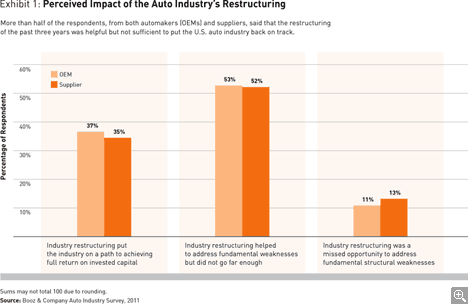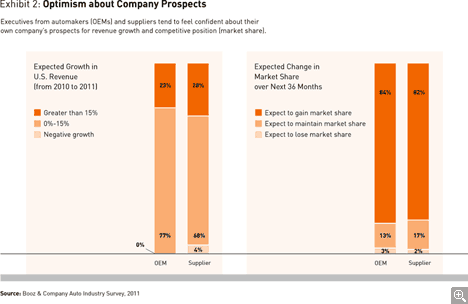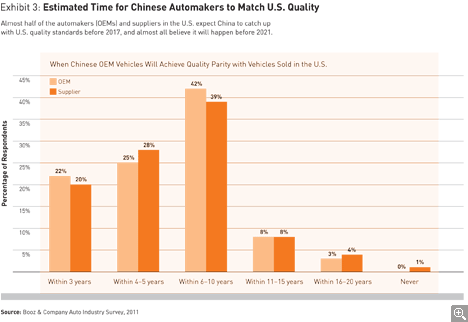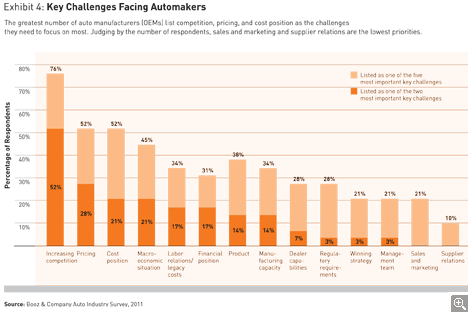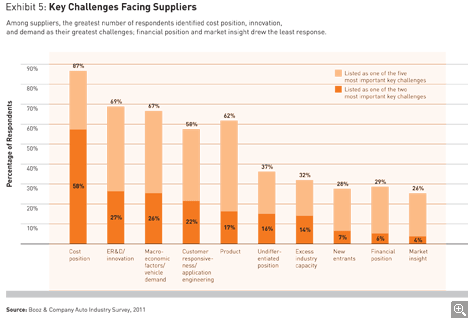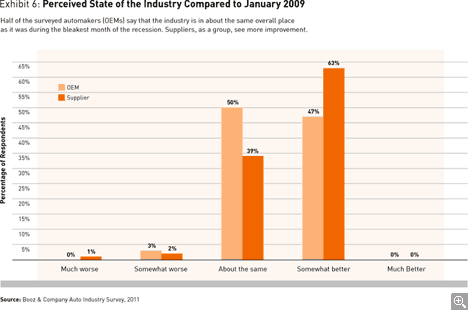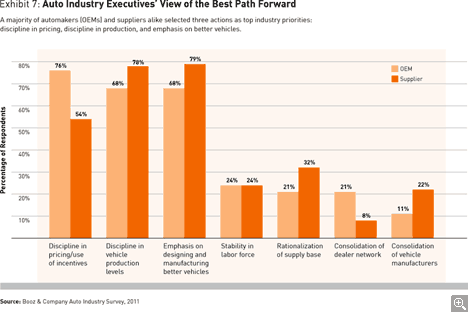Is the U.S. Auto Industry Ready for Economic Recovery?
A new survey of U.S.-based automotive executives shows they are optimistic about their own companies — but pessimistic about the auto industry’s prospects at large.
To many people, the U.S. auto industry appears to be on the mend. Indeed, many analysts foresee a rapid and, by some measures, dramatic rebound in auto sales in the next few years. But auto executives themselves, even when their own businesses are doing well, aren’t yet ready to break out the champagne. That sentiment is one of the intriguing results of a new Booz & Company survey of more than 200 executives from major automobile companies (original equipment manufacturers, or OEMs) and the auto suppliers that make components for them. Although leading auto industry forecasters have predicted that light vehicle sales will rise to more than 16 million in 2015, up from 11.6 million in 2010, survey respondents expect a much more modest uptick — to only 13.5 million in 2013 and 14.5 million in 2015.
This caution stems, in large part, from uncertainty about the economy, credit availability, and overall demand. But there is another major reason: By the executives’ own reckoning, most automobile companies have not fully gotten their managerial houses in order. Almost half of the survey respondents said that the recent auto industry restructuring in the U.S. did not go far enough. Two-thirds of them said that as a group, automakers and auto suppliers were not yet on the path to achieving sustained full return on invested capital. (See Exhibit 1.) Although there has been significant improvement in both product strategy and operations, respondents see a great deal of work still to do — and a worrisome possibility that the industry could slide back into its old ways. In fact, the auto executives view the overall outlook for their industry as so potentially tenuous that almost 30 percent said they expect a major automobile company to fail in the next two years.
Yet despite their concerns about auto industry prospects and short-term growth, respondents were remarkably upbeat about the possibilities for their own business: More than 80 percent said that they expect their company to increase market share in the next 36 months. Moreover, some 30 percent of supplier respondents and 25 percent of OEM respondents expect their companies’ revenue growth to exceed 15 percent this year. (See Exhibit 2.) And 60 percent of auto suppliers said they are actively pursuing acquisitions.
This disconnect between the perceived state of the auto industry and the prospects for individual companies can be traced in part to the fact that domestic automakers and auto suppliers are generating some of the best financial returns in many years. Since the global recession began, bankruptcies and substantial restructurings in the auto industry, as well as a stronger focus on lean factories and new union agreements, have had an effect. They have significantly reduced operational costs, sanitized balance sheets, and eliminated health and pension legacy expenses, or at least helped to make them more manageable. However, to translate these gains into ongoing improvements and more sustainable profitability, auto companies must address fundamental structural weaknesses. In a relatively saturated customer marketplace, automobile executives are understandably reluctant to count solely on consumer confidence and access to credit to drive near-term sales. But can they transform their companies by developing appealing vehicles with competitive economics, by increasing exports and further penetrating global markets, by introducing breakthrough technologies, and by finding other ways to thrive in an industry that will be increasingly in flux and more demanding than ever before? The survey responses suggest that the answer is not yet certain.
“If you look at the industry before the sales downturn, it was hyper-inflated,” says Ernest Bastien, vice president of retail market development at Toyota USA. “People were using their home equity and easy-to-get loans to take advantage of extraordinary incentives that were being offered. In fact, the industry was not as robust as it looked. Going forward, automakers are going to have to rely on a more fundamental but complex equation for growth: making the right number of high-quality cars and proving to consumers that their brand is the best in terms of total cost of ownership, drivability, and reliability.”
A World of Increasing Competition
In January and February 2011, a team at Booz & Company set out to calibrate the attitudes and prospects of the U.S. automobile industry through an online survey. Coming from more than 40 leading automobile manufacturers and suppliers, the 200 participants included more than 50 corporate leaders at the C-suite or executive vice president level. More than 70 percent of the companies represented were North American, 15 percent were Asian, and 12 percent were European.
One telling response concerned the challenges that major automobile manufacturers will face in the next three years. More than half of the automaker executives (not including the suppliers) chose increasing competitive pressure as either the first or second most critical challenge for their companies. Seventy-six percent listed it among their top five. One reason for this response, of course, is the continued growth of Japanese manufacturers such as Toyota and Honda; they remain formidable rivals to the Detroit Three. Korea’s Hyundai and Kia have also garnered much attention recently with aggressive and successful growth strategies, built on compelling lineups offered at appealing prices and produced in efficient factories.
But the looming presence of Chinese companies also casts a large shadow. Fully 90 percent of the survey respondents said that Chinese automakers would be making cars equal in quality to American-made vehicles by 2021. (See Exhibit 3.) About half of all respondents (from among both OEMs and suppliers) said that milestone could be reached by 2016. This is a startling response, because of the speed and immensity of this change in the most highly competitive and open automobile market in the world. In other words, the executives believe that companies like Geely Automobile, which acquired the Volvo brand from Ford, and BYD, partially owned by Warren Buffett, will achieve in 10 years what Toyota and other Japanese companies took nearly 30 years, and Korean automakers about 20 years, to do.
Judging by the frequency of response, the next greatest challenges that automakers see facing them are pricing and cost position. The perennial issue of bringing down the unit cost of a given automobile will be even more of a concern, especially as lower-priced automobiles are introduced by new competitors. We can thus expect to see automakers place continued emphasis on operating with lean organizations and increasing their productivity. The macroeconomic environment and labor relations were also named as important challenges by relatively high numbers of respondents. Other potential problems were rated much lower as concerns; these included the quality of management teams at the major automakers, the appropriateness of the strategy followed by the respondents’ companies, the capabilities of dealers, and, significantly, relations with auto suppliers. (See Exhibit 4.)
Although diverse, the responses suggest a clear view of the best road to success for automakers. This includes bringing the right portfolio of vehicles to market with viable investment economics; appropriate levels of quality, reliability, and durability; production aligned with market demand; and strong brand and consumer equity. These factors are prerequisites for earning an industry-competitive return on invested capital. And automakers must juggle all these strategic objectives while operating with greater price discipline than they had during the boom years of the early 2000s, when credit was cheap and customers were more willing to make high-ticket purchases.
“Typically, auto companies would watch competitors, and when one’s models became old compared to the competition and when the competition produced more product than they could sell, pricing pressure hit and everyone began to discount or offer incentives,” says Torsten Buhrke, director of corporate planning at Kia Motors America. “If we go back into that way of thinking — tackling overcapacity with price discounts — the industry hasn’t learned much. But if we keep inventories low and production linked to demand, we have an opportunity to take advantage of beneficial demographics, replacement levels, and breakeven points to enjoy a highly successful next few years.”
The Prospects for Auto Suppliers
At first glance, the survey seems to convey a great deal of optimism about the prospects for automobile suppliers in the United States. Many suppliers have been extremely successful in cutting out operational costs and in reducing breakeven points, and they are consequently bullish about revenue gains this year. In fact, sales are expanding so fast now that the lion’s share of respondents (42 percent) pointed to difficulties in hiring enough engineers as the main obstacle to growth.
But there are also warning signs. For many auto suppliers, the current levels of revenue and profit reflect a bounce back from extreme lows in sales during the downturn, as well as pricing relief provided by the OEMs. In other words, they may turn out to be temporary conditions. Other factors may also change; for example, as industry conditions improve, general levels of R&D activity will rise, leading to higher innovation-related costs for many suppliers.
Survey respondents welcome the current turnaround — but they do not attribute it to fixes in the fundamental problems that have plagued auto suppliers for the past decade. For example, many suppliers continue to find themselves in an unsustainable position when it comes to value. With an overabundance of competitors in their product categories, they lack the leverage to set terms that would earn them a positive return on their invested capital. Instead they become, in effect, low-cost order takers and executors. In the long run, this leads to unstable supplier relationships and lower investments in research and development. As auto components become commodities, the industry becomes less equipped to compete overall. This dynamic is reflected in the two concerns most widely named as critical challenges by suppliers: cost position and engineering R&D innovation. (See Exhibit 5.)
As the business heats up and auto suppliers compete for OEM customers, they will need to rethink their place in the auto industry ecosystem and try to differentiate themselves from their competitors. They can charge sustainable prices only when they stand out — through innovation, better performance, or lower cost structures, or through helping to create end-user demand (for example, via well-crafted and well-designed electronic entertainment systems, better headlamps, or other amenities).
To us, the survey results suggest that many auto suppliers may not be well positioned to manage their relationships with OEMs in this way. When asked which capabilities would be most important going forward, respondents from supplier companies favored three: cost position (with 56 percent ranking it in the top two approaches), product quality (37 percent), and having the global reach to support OEMs (35 percent). Innovation and product performance followed at 21 percent and 19 percent, respectively. As previously noted, executives ranked supplier relations as the automakers’ lowest concern, whereas suppliers said that capturing the lowest cost position and making sure that they satisfied the demands of OEMs globally were the most vital predictors of their success. Finally, auto suppliers said that among the least important issues were having a well-defined strategy (selected by 11 percent) and deep market insight (4 percent). Yet for most businesses, these are two critical prerequisites for achieving a differentiated market position, and thus long-term viability.
“A product’s price is directly proportional to the value it creates,” says David Johnson, CEO of Achates Power Inc., which is developing an energy-efficient engine. “Any time that you aren’t delivering a unique technology or unique features that will create market demand or fill a real need in the market, your product becomes commoditized — and the next thing you are doing is price and quality competition. That’s not a long-term winning formula.”
Some suppliers will undoubtedly benefit from the influx of new automakers in the U.S. market, particularly if the survey forecasts about Chinese entrants come to pass. But in mature markets like the U.S. or Europe, where there are more registered cars than licensed drivers, the possibility of substantially increasing domestic volume is not a viable path for growth. Instead, auto suppliers must learn how to enter other markets, including emerging economies. OEMs are increasingly looking for suppliers who can grow with them around the world. Scale matters in such an endeavor and suppliers may need to rethink their approach to consolidation. They may also need to develop the capabilities for M&A. Finally, most auto suppliers need to think carefully about their own distinctive capabilities: What can they do better than anybody else to create a unique place in the competitive landscape of this industry?
Where the Industry Goes Next
Among the more telling findings of the survey is a suggestion that the industry has missed an opportunity to fully address the structural weaknesses — for example, too much production chasing too few customers — that rendered it generally unable to hold its own in the worst of the recession. More than 50 percent of the OEM executives believe that overall, the auto industry is either in the same shape as it was in January 2009 or in worse shape; in fact, no respondent, automaker or supplier, said that the industry was in much better shape. (See Exhibit 6.)
Where do OEMs and suppliers go from here? Respondents laid out a series of priorities for automakers and suppliers that include instilling greater discipline in pricing and production as well as emphasizing vehicle quality. (See Exhibit 7.) And stepping back to look beyond the survey, drawing on our experience and on interviews with several respondents, we formed some further conclusions about the best path for each of them to take. OEMs and suppliers face two different sets of priorities.
The automakers must:
1. Focus even more intensely on building attractive vehicles and rebuilding brands. Cars and trucks are still among the most visible, emotional purchases consumers make. In the current environment of frugality and practicality, U.S. car buyers need to be given reasons to “fall in love” again. They also want to reconnect with heritage brands that hark back to simpler times.
2. Create vehicles with exciting design and styling; superior quality, reliability, and durability (QRD); and technological innovation. Although the QRD of vehicles sold in the U.S. is better than ever, there are still meaningful gaps between the highest-ranked companies and the rest of the pack, especially in longer-term reliability and durability. In addition, new opportunities exist to deliver significant and differentiated value with breakthrough innovations in power-train technologies, safety technologies, and “smart car” systems (the use of sensors and wireless to connect vehicles, avoid collisions, and manage traffic flow).
3. Create product portfolios and development systems in which each vehicle produces a positive return on investment. The strategy of counting on a few blockbusters (namely larger vehicles) to generate most of the portfolio’s returns is no longer sustainable in a more competitive and smaller U.S. market.
4. Continue minimizing material and structural costs, and do so faster and more effectively than key competitors. Automakers need to build and deploy capabilities to bring new technology to market more cost-effectively, thereby earning fair returns for their product innovations.
5. Prepare for a more globally competitive landscape. All signs indicate that the U.S. market will become more crowded over the next decade with competitors that are early adopters of advanced technologies and that have better cost structures and greater experience in emerging market segments.
Auto suppliers should:
1. Better manage their portfolios, focusing on the markets where they have the greatest capabilities and opportunity to create a sustained competitive advantage. Some companies can prosper making disparate components, but most do not have the resources and skills to do this well. Once they have narrowed their strategic focus, they should ensure they have the capabilities in place to meet changing market needs and sourcing requirements. (For example, they may need to develop a global manufacturing capability.)
2. Continue to aggressively manage costs. Suppliers have successfully reduced operational and structural costs during the downturn. Now, they need to make sure that these expenses don’t creep back in as volumes ramp up. They must also discipline themselves to stop chasing vehicle programs that cost more than they return in the long run. Often, these OEM orders are drawn from unrealistic volume projections by the automakers that the suppliers accept credulously, even if the economics don’t make sense. When possible, suppliers and OEMs should promote collaborative cost-based agreements that give automakers full transparency into relevant supplier operations and that allow suppliers to earn a fair return on investment.
3. Recognize that industry consolidation is likely to intensify. Every supplier must proactively assess the industry structure for each of its core businesses and reconsider its role: Is it a buyer or a seller?
4. Accelerate efforts to find greater leverage with their high-quality product lines. Every supplier must innovate wisely, focus on features that customers are willing to pay for, respond directly to consumer demand, and establish itself as the company that is best positioned to help solve an OEM’s problems.
You don’t need a survey to know that the U.S. auto industry is in a period of extraordinary transition. Whether considering the development of alternative drive trains, the need to find ways to fine-tune designs and manufacturing processes, or the raft of new global competitors, it’s fair to say that only the most flexible, lean, and well-managed companies will survive. With that in mind, perhaps the survey’s greatest value is its central finding: Despite the general optimism in the auto industry today, as well as the real improvements in efficiency, quality, and lean practices that have been made, many executives are still bracing themselves for further change. They will need all the optimism — and the skill — they can muster.![]()
Author profiles:
- Scott Corwin is a partner with Booz & Company based in New York. He has extensive experience in developing enterprise transformation strategies for clients in the automotive, media, information, and consumer industries.
- Brian Collie is a principal with Booz & Company based in Chicago. He specializes in working with automotive and industrial companies in business unit strategy and transformation.
- Patrick Mulcahy is a senior associate with Booz & Company based in Cleveland. He focuses on product strategy and M&A for automotive and industrial clients.
- Also contributing to this article were Booz & Company Senior Associate Tim Lepczyk, Associate Gaurav Panwar, and Consultant Malavika Srinivasan.


